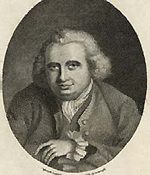Darwin’s Life
In the summer of 1831, Charles Darwin had an the offer to accompany His Majesty’s Ship Beagle on a five-year, around-the-world voyage of exploring, surveying, and collecting. Darwin’s plans were hampered only by the qualms of his father, who wondered if, at the age of 22, he would ever settle down!

Erasmus Darwin (1731-1802), 1795
For at this point, Darwin had already unsuccessfully tried a career in medicine, his family’s profession. Darwin’s grandfather, Erasmus Darwin (1731-1802), and his father, Robert (1766-1848), were successful physicians, while his older brother Erasmus (1804-1881) also trained in medicine and helped Darwin through his medical studies. The family was associated with the progressive, at times radical gentry of the provinces. The Darwins had made their fortunes among the new class of British industrialists of the late 18th century; Darwin’s other grandfather was Josiah Wedgwood (1730-1795), the founder of the famous and highly successful porcelain company. The family roots were in science and in reform, political and social, supporting abolitionism, freedom of religious practice, and political liberalism. By Charles’s time, the trend had even turned towards radicalism. Brother Erasmus’s London circle included feminist Harriet Martineau (1802-1876) and Scottish moralist Thomas Carlyle (1795-1881), and in the late 1830s Charles often found himself in this group.
But in the 1820s and early ’30s, the choice of a profession remained the dominant concern. Starting in 1825, Darwin had trained in medicine at Edinburgh University, a premier venue. In his two years there, he picked up a strong interest in natural history and geology, and the knowledge that medical practice was not for him. His father moved him to Christ’s College at Cambridge University, to secure a future in the Anglican priesthood, the refuge of younger English sons. But botany and geology interested Darwin far more than did theology. The connections he made—especially with botany professor John Stevens Henslow (1796-1861)—had led to the Beagle invitation. His father was persuaded that the voyage would help his son’s prospects, and Darwin sailed on the Beagle on December 27, 1831.
Last Reviewed: May 8, 2014


